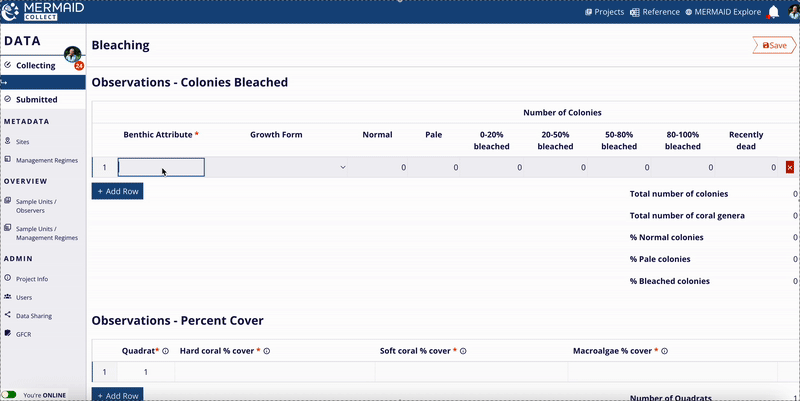When you’re ready to enter bleaching data from your dive sheets, go to your project’s Collecting page and click + Add sample unit. Select the Bleaching method to open a sample unit form organized into four main sections: Sample event, Transect, Observers, Observations.
The bleaching method supported in MERMAID follows the rapid assessment field method as described in the McClanahan and Darling protocol. Each sampling unit consists of a collection of quadrats surveyed during a single dive or snorkel, with bleaching severity assessed for individual coral colonies and recorded at the genus level.
A more detailed description and video tutorial of the method can be found in Supported Survey Methods.
Completing a bleaching sample unit form
Note: Required fields are marked with a red asterisk (*). These include site, management regime, observers, and key transect attributes. Optional fields include time, visibility, current, tide, and notes. Helper text is available for every field—just click the info icon next to a label to view tips, definitions, and example entries. |
1. Sample event
This section defines where and when the bleaching survey data was conducted. You'll select:
Site – From the list of sites added to the project. Learn more about adding sites here.
Management regime – From the list of management regimes added to the project. Learn more about adding management regimes here.
Date of survey – The date the sample unit was collected.
Each sample event (site, management regime, and date) is used to group your sample units for the % colonies by bleaching severity category calculations in MERMAID. Read more in Learning about Our Reef Health Metrics.

2. Quadrat collection
Protocol-specific fields for the bleaching survey:
Depth (m)
Quadrat size (m2)
Optional fields – Reef slope, Visibility, Current, Relative depth, Tide, Notes.
Some fields use dropdowns with standardized values (e.g., visibility, current, relative depth); others are free text or numeric fields for flexibility (e.g., depth, quadrat size).
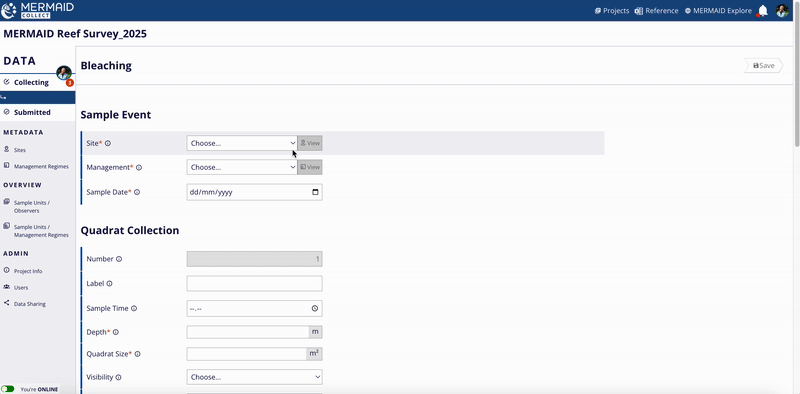
3. Observers
In this section, assign the person(s) who collected the observations underwater:
Select from the list of project users
Click to add or remove names
At least one observer is required per sample unit
Accurate attribution helps with training, reporting, and quality assurance.
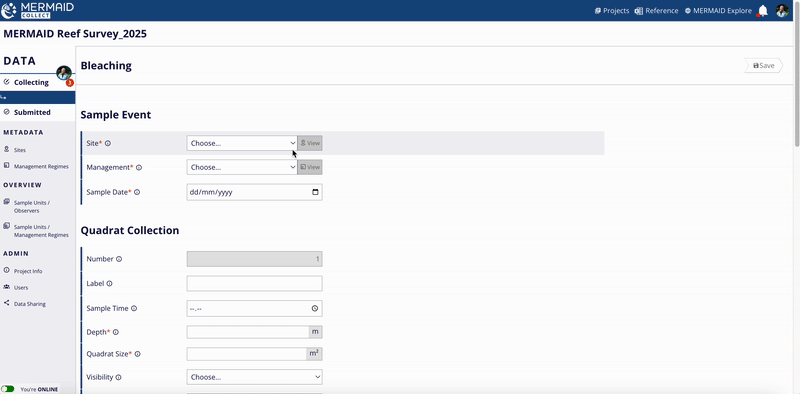
4. Observations
Here’s where you enter your actual data (raw observations):
In MERMAID Collect, observations from this survey are recorded in two separate Observations tables:
Observations - Colonies bleached table records the total number of colonies in each bleaching category (i.e., normal, pale, 0-20% bleached, 21-50% bleached, 51-80% bleached, 81-100% bleached, recently dead) per coral genus (Benthic attribute).
Observations - Percent cover table records the % cover of hard coral, soft coral, and macroalgae for each quadrat.
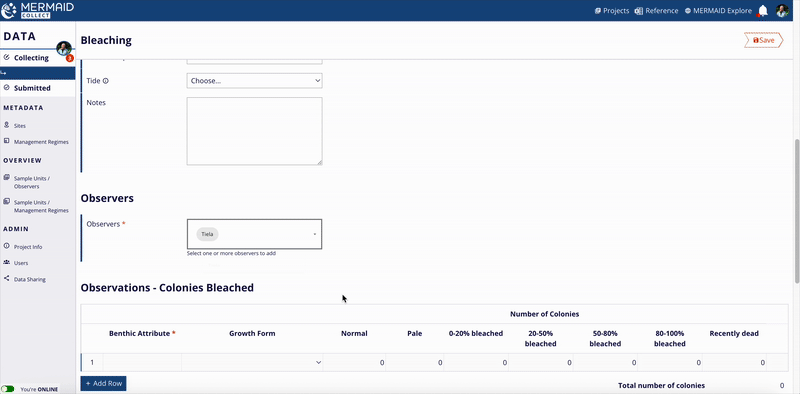
Suggesting a new benthic attribute
If a benthic attribute isn’t yet listed in the dropdown:
Type its name in the Observations table.
Select Propose new benthic attribute...
Enter the coral genus/family/top-level category in Parent and the species/genus name in Name.
Click Next to review.
Click Send to MERMAID to submit it for review.
If the parent (genus/family/top-level category) is missing, select Contact us for help to notify the MERMAID team.
The benthic taxonomy in MERMAID is standardized using the World Register of Marine Species (WoRMS) to ensure consistent species classification.
Note: Check the benthic attribute in WoRMS to ensure the species name is accepted before submitting. Your entry will be provisionally included but becomes official only after being reviewed and approved by the MERMAID Team. |
You can download the full list of available benthic attributes using the Reference icon in MERMAID Collect.
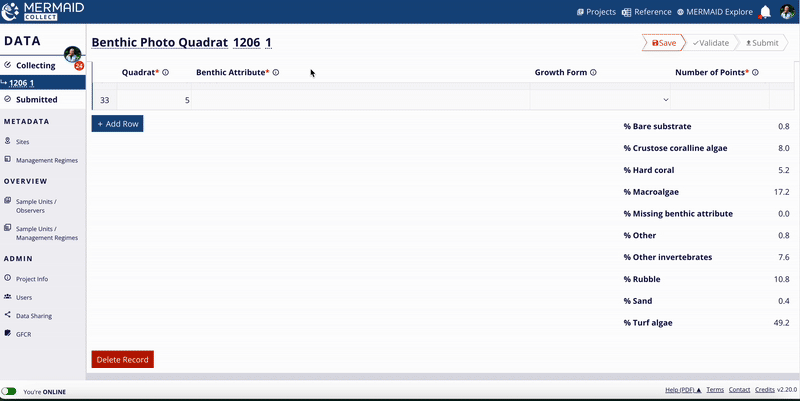
Tips for data entry: Keyboard shortcuts and predictive text
Use these keyboard shortcuts and the predictive text to move quickly through the Observations table in a sample unit form:
Use the Tab key to move across fields in a row.
Use the Up and Down arrow keys to scroll through benthic attributes suggestions.
Under the column Benthic attribute, type a few letters of your observation (e.g., Acropal for Acropora palmata), then use the arrow keys and Enter/Return/Tab to select it from the matching dropdown options. Or type until there’s only one option and press Enter/Return.
Press Tab at the end of a row to duplicate the observation in the next row—useful for entering consecutive observations of the same benthic attribute in a transect.
Press Enter/Return to start a new row and begin typing the next observation.
This helps ensure consistent naming and speeds up your workflow—especially when entering lots of observations.
Metric summaries in a bleaching sample unit
As you enter observations in a sample unit, MERMAID automatically calculates and displays key metric summaries to provide quick insights and support data quality checks — all available even when you’re offline.
For the bleaching method, MERMAID calculates:
Total number of coral colonies, and coral genera
% normal colonies, pale colonies, and bleached colonies
Average % hard coral cover, soft coral cover, and macroalgae cover
These metrics are displayed beneath the Observations tables and help you evaluate the bleaching severity in real time.
Read more about these calculations in Learning About Our Reef Health Metrics.
